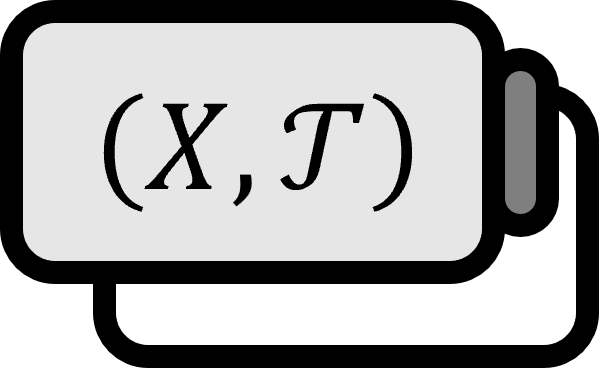Bases and Local Bases in Topology
Definition
Let’s say topological space $\left( X , \mathscr{T} \right)$ with respect to $\mathscr{B} , \mathscr{B}_{x} \subset \mathscr{T}$.
- When we say $B_{\lambda} \in \mathscr{B}$, if for every $U \in \mathscr{T}$ there exists a neighbourhood $\Lambda$ that satisfies $$ U = \bigcup_{\lambda \in \Lambda} B_{ \lambda } $$ then $\mathscr{B}$ is called a basis for $\mathscr{T}$. In this case, the topology $\mathscr{T}$ is said to be generated by $\mathscr{B}$.
- When we say $x \in X$, if for every $B \in \mathscr{B}_{x}$ there exists $x \in B$ and for all $U \in \mathscr{T}$ that include $x$, $$ x \in B \subset U $$ there exists $B \in \mathscr{B}_{x}$ that satisfies this, then $\mathscr{B}_{x}$ is called a local basis at $x$.
Explanation
Since the definition is quite confusingly written, it will be much more comfortable to conceptually grasp it before trying to solve exercises. Don’t try too hard to find the relevance with the basis in linear algebra; the definition isn’t much similar besides the feel.
In a word, a basis is a set that can be made by the union of the given topology. Since there’s no need to think about the intersection, just gather ‘small’ open sets in the topology and compose them.
For example, in a metric space, the set of all open balls becomes a basis for the metric space.
Necessity
From the perspective of studying from books, it feels difficult and puzzling to think about finding a basis $\mathscr{B}$ in the topology $\mathscr{T}$ like in linear algebra. On the contrary, if you adopt the standpoint of generating, that is, making a topology from a basis, the concept of basis cannot be handier.
For instance, if you wanted to create a topological space using sequences of natural numbers, to base the topology on the first term, $B_{1}$ would be the set of sequences with first term $1$, $B_{2}$ would be the set of sequences with first term $2$, $B_{k}$ would be the set of sequences with first term $k$… And you could approach this by considering them as open sets. The problem is that there’s no union $B_{1} \cup B_{2}$ in $\mathscr{T}$. Because there are no sequences whose first term is either $1$ or $2$, but if you just assume every possible union in $\mathscr{B} = \left\{ B_{k} \right\}_{k \in \mathbb{N}}$ exists, the task becomes much easier. This is truly making good use of the topology generated by a basis.
Criterion 1
Criterion for a basis: For the entire set $X$, $\mathscr{B} \subset \mathscr{P} (X)$ is the basis of $X$ when the following two conditions are met:
- (i): $\displaystyle X = \bigcup_{B \in \mathscr{B}} B$
- (ii): For all $ B_{1} , B_{2} \in \mathscr{B}$ such that $x \in B_{1} \cap B_{2}$, there exists $B_{x} \in \mathscr{B}$ satisfying: $$ x \in B_{x} \subset B_{1} \cap B_{2} $$
This criterion is a useful theorem that can be effectively used in actual problem solving, so make sure to remember it. Depending on the textbook, this criterion could rather be the definition.
A local basis, unlike the general concept of a basis which is for the entire topology, is a concept only dealing with a given point. Although it’s a lengthy and complicated explanation, in summary, it only needs to collect the ‘smallest’ among all open spaces that include $x$ to satisfy the conditions for a local basis.
For example, in a metric space, the set of all open balls centered at $x$ becomes the local basis at $x$.
Relation between Basis and Local Basis
Let’s say $X$ is a topological space.
If $\mathscr{B}$ is a basis for $X$, then $\mathscr{B}_{x} := \left\{ B \in \mathscr{B} \ | \ x \in B \right\}$ is a local basis at $x \in X$. Conversely, if for every $x \in X$, $\mathscr{B}_{x}$ is a local basis, then $\displaystyle \mathscr{B} := \bigcup_{x \in X} \mathscr{B}_{x}$ is a basis for $X$.
Precautions
Note that it’s not a necessary and sufficient condition, so for the converse to hold, it’s important to consider local bases at all points.
Munkres. (2000). Topology(2nd Edition): p78. ↩︎
